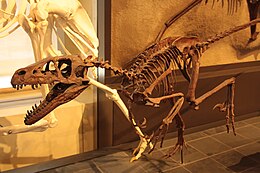| Dromaeosaurus Temporal range: Late Cretaceous (Campanian to Maastrichtian), [1] Possible Late Maastrichtian record[2]
| |
|---|---|

| |
| Reconstructed skeleton, Canadian Museum of Nature | |
| Scientific classification | |
| Domain: | Eukaryota |
| Kingdom: | Animalia |
| Phylum: | Chordata |
| Clade: | Dinosauria |
| Clade: | Saurischia |
| Clade: | Theropoda |
| Family: | †Dromaeosauridae |
| Clade: | †Eudromaeosauria |
| Subfamily: | †Dromaeosaurinae |
| Genus: | †Dromaeosaurus Matthew & Brown, 1922 |
| Type species | |
| †Dromaeosaurus albertensis Matthew & Brown, 1922
| |
Dromaeosaurus (/ˌdroʊmiəˈsɔːrəs, -mi.oʊ-/;[3] lit. 'running lizard') is a genus of dromaeosaurid theropod dinosaur that lived during the Late Cretaceous period (middle late Campanian and Maastrichtian), sometime between 80 and 69 million years ago, in Alberta, Canada and the western United States. The type species is Dromaeosaurus albertensis, which was described by William Diller Matthew and Barnum Brown in 1922. Its fossils were unearthed in the Hell Creek Formation, Horseshoe Canyon Formation and Dinosaur Park Formation. Teeth attributed to this genus have been found in the Prince Creek Formation. Dromaeosaurus is the type genus of both Dromaeosauridae and Dromaeosaurinae, which include many genera with similar characteristics to Dromaeosaurus such as possibly its closest relative Dakotaraptor. Dromaeosaurus was heavily built, more so than other dromaeosaurs that are similar in size, like Velociraptor.
- ^ Dinosaurs: The Most Complete, Up-to-Date Encyclopedia for Dinosaur Lovers of All Ages. Random House. 2007. p. 384. ISBN 9780375824197. Retrieved 5 August 2020.
- ^ Wilson, L. E. (2008). "Comparative Taphonomy and Paleoecological Reconstruction of Two Microvertebrate Accumulations from the Late Cretaceous Hell Creek Formation (Maastrichtian), Eastern Montana" (PDF). PALAIOS. 23 (5): 289–297. Bibcode:2008Palai..23..289W. doi:10.2110/palo.2007.p07-006r. S2CID 140668860.
- ^ "Dromaeosaur". Lexico UK English Dictionary. Oxford University Press. n.d.